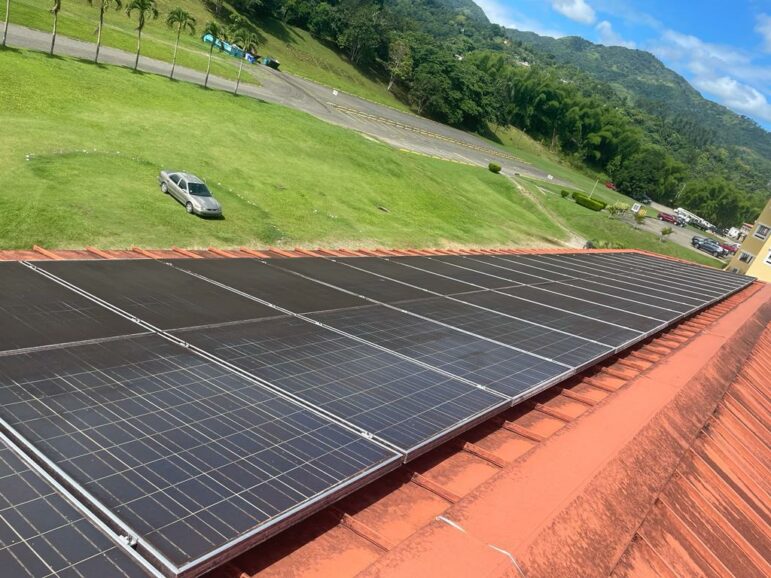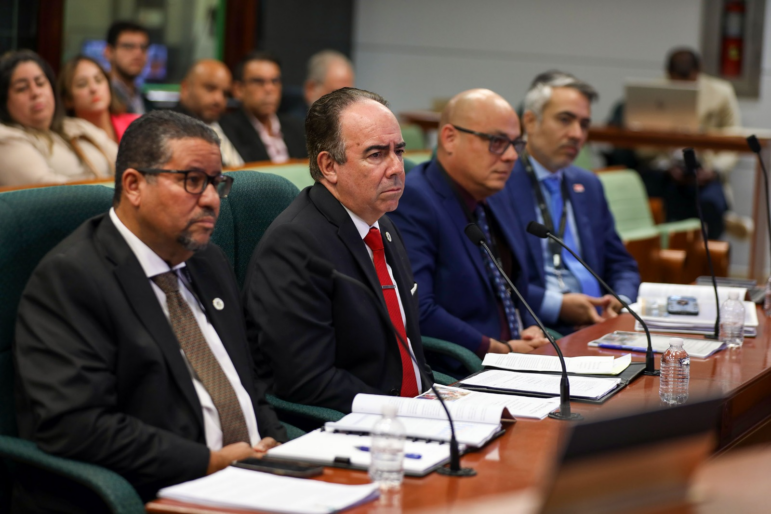What are campuses doing to save energy?
From June 2021 — when private company LUMA began managing power distribution — through June 2022, the Puerto Rico Energy Bureau approved five consecutive electricity rate increases. This fee is reviewed quarterly to account for factors such as inflation or changes in fossil fuel prices.
One of the alternatives that all units of the UPR system have tried to save energy is replacing lighting fixtures and air conditioning equipment with more efficient ones and installing solar panel systems in some buildings.
The Medical Sciences Campus (RCM, in Spanish) replaced the lighting with LED technology, as well as the air conditioning units and five coolers with high-efficiency units. In addition, the facility has a series of regulators in the electrical room of the Guillermo Arbona Irizarry building that help conserve energy.
They installed motion sensors for the hallway lighting and variable speed drives to control the air conditioning fans in the same building. The library has solar panels.
Other energy-saving proposals in the pipeline include installing tables with solar panels, continuing the replacement of light fixtures, and instructing employees to turn off lights and equipment when they finish their shift. In addition, the RCM management is considering conducting an energy consumption study.

Tables with solar panels have been placed on the Río Piedras Campus where students can charge electronic devices. Four tables were placed between the buildings of the Natural Sciences and General Studies schools. Courteous photo
As in the RCM, the Ponce Campus has replaced air conditioning units and lighting with LED technology and is checked daily to ensure that the units are turned off. Plans to increase energy savings include moves by the Ponce campus administration to install an automated lighting and air conditioning control system for the academic building, as well as installing a renewable energy system with funds from the Development Block Grant Community Mitigation Fund (CDBG-MIT). .
In 2012the Utuado Campus received $100,000 to install a solar energy system in the library, and more recentlya grant from a non-profit organization Second nature to transfer the operation of the campus to solar energy. Like other units of the UPR system, they also installed LED lighting and motion sensors in various areas.

The Utuado Campus, which has had solar panels since 2012, had the lowest electricity payment disparity.
Photo provided by the University of Puerto Rico, Utuado Campus
The Cayey Campus also received $2.6 million scholarship of the United States Department of Education to install solar panels in the Emergency Operations Center, as well as power generators. In end of February, the campus administration had to incur an unexpected expense of $38,305 for a failure of an electrical substation on campus, and this expense is not final as they have yet to purchase a transformer costing approximately $379,000 before installation. Although the Security Building has solar panels, the system does not work.
In April, the operation of the Río Piedras Campus was also interrupted by an electrical outage that resulted in costs for cleaning and mold removal in several buildings after service was restored.
On this issue, Delvin Caraballo, the representative of undergraduate students for the UPR board of directors, said in a letters directed to that agency that restoring the electrical systems to the conditions they were in prior to the hurricanes on the Río Piedras campus could cost $90 million.
The budget memorandum recently submitted to the House of Representatives warns that only 15% of the institution’s General Fund is available to pay for infrastructure maintenance, which includes major repairs and reconstruction of critical infrastructure, such as substations.

Restoring the electrical systems of the University of Puerto Rico’s Río Piedras campus to pre-Hurricane María conditions could cost $90 million.
Photo by Norenid Feliciano | Center for Investigative Journalism
The administration of that facility confirmed that the replacement of the main substation, central plant and substations of 78 buildings is underground, in addition to the integration of co-generators that will serve as redundancy for the main substation, but did not specify when the work will be completed . It also plans to install photovoltaic systems in 21 buildings. All areas of the campus have now been illuminated with LED technology and 37 tables with solar panels have been installed.
Meanwhile, the Bayamón Campus plans to build an electric microgrid together with the surrounding schools and replace the high-intensity lighting with LED. The UPR central administration has not specified when or to which entity the proposal for the Bayamon Campus microgrid will be submitted, or if it will be developed with neighboring public schools.
On the Carolina Campus, there is a building that works with a 405 solar photovoltaic system panels and there are plans to install panels in four more buildings in the next six months. As with Medical Sciences, they changed all their lighting to LED and the air conditioning cooling systems.
However, Campus Rector José I. Meza Pereira warned in October 2020 during the presentation of the Carolina campus energy plan that “90% of the budget allocated for service and maintenance of the physical plant goes toward paying the [the electricity bill].”
On the Humacao Campus, LED lighting and energy-efficient equipment have been installed in the bathrooms. Ingrid Vázquez, the director of the Campus Press and Communications Office, also said that a proposal was submitted to the Housing Department in April for Infrastructure Mitigation Program (INFRA-MIT) funds to replace the air conditioners with energy-saving units.
Solar panels have been installed in Arecibo, the building that houses the Center for Preschool Development and the labs for physics and chemistry. For example, solar spots have been placed in various places, traditional lighting has been replaced by LED lighting and solar panels have been installed in the administration building.
In Mayagüez, the chemical engineering building has a lab with a solar panel and battery system. Like the Humacao Campus, the Mayagüez campus, the administration submitted a cogeneration proposal for CDBG-MIT funds in late April, which would reduce energy costs by 50%.






Be First to Comment